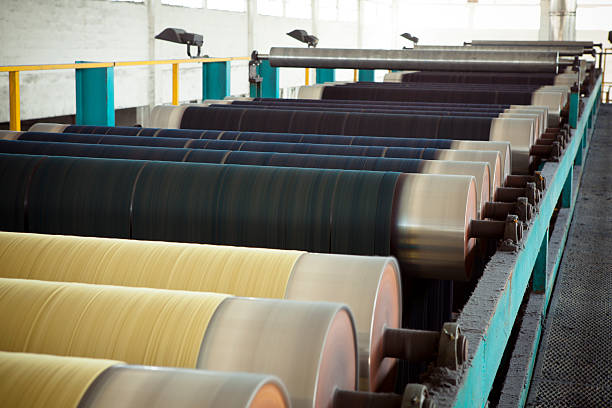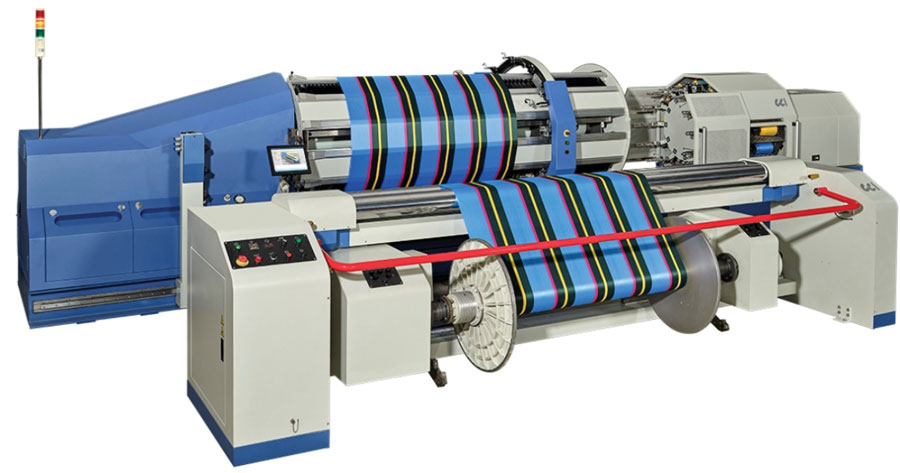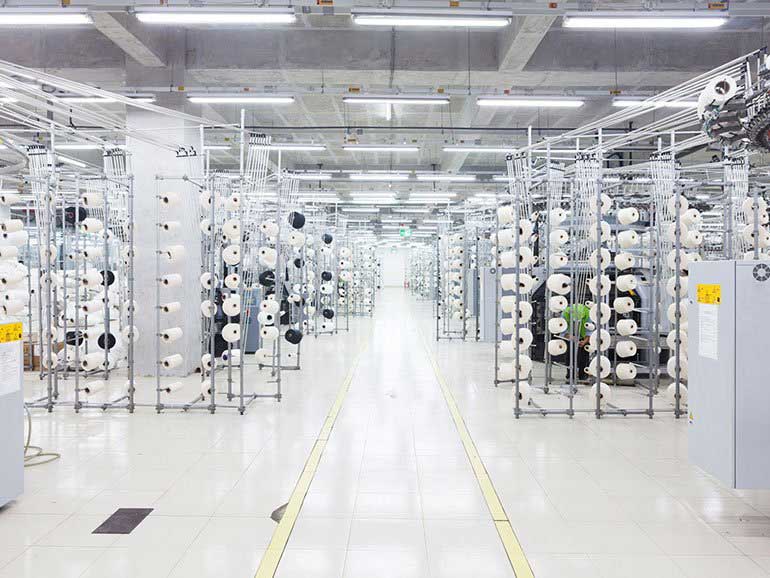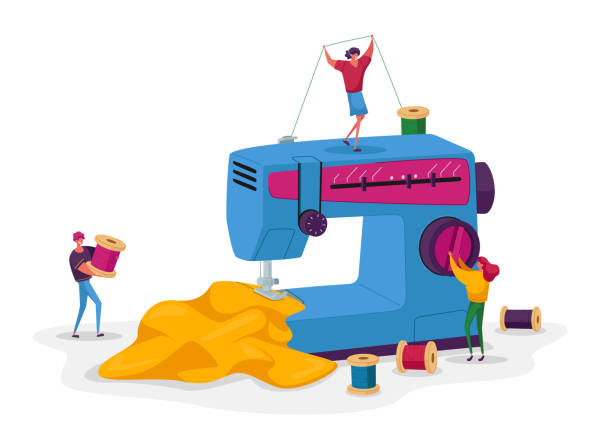Knit composite refers to dyeing yarn into fully knitted, ready-made items for shipment to the consumer. A knit composite factory involves several stages and operations, such as yarn dyeing, knitting, fabric dyeing, washing, printing, embroidery, garment manufacture, etc. This article has provided a complete list of the machinery used in knit composite manufacturing.

Knit Composite Process List:
- Yarn Dyeing Section: Yarns are dyed before fabric production, using techniques such as package dyeing where yarns are wound on perforated cones and placed in a dye tank.
- Knitting Section: Knit fabrics, which stretch more than woven fabrics, include types like weft knits (plain, rib, purl, pattern, double knits) and warp knits (tricot, raschel, Milanese).
- Knit Fabrics Dyeing: Knit fabrics are dyed using methods like the exhaust or batch-wise approaches.
- Dyeing Finishing: This process involves adding natural colors, primarily red, yellow, and blue, to textiles using various dyeing methods.
- Washing Section: Garment washing alters the appearance, size, comfort, and style of clothing, particularly denim.
- All-over Print Section: This involves a design that covers the entire surface of a garment, often used in streetwear and typically applied via screen printing.
- Screen Printing Section: This method transfers a stenciled image onto a flat surface using ink, a mesh screen, and a squeegee, suitable for materials like paper, cloth, metal, plastic, glass, and wood.
- Embroidery Section: A crucial area in garment manufacturing where embroidery is done per buyer’s specifications, traditionally by hand.
- Knit Garments Cutting Section: The process involves cutting spread fabric into sections that match the pattern pieces on a marker.
- Knit Garments Sewing Section: This section involves sewing together different parts of cut pieces, with various operators performing specific tasks.
- Knit Garments Finishing Section: The final step in preparing packaged garments for sale, crucial for product quality and presentation.
Textile Dyeing Section in Knit Composite Factory:
In the realm of textile industry, dyeing entails altering the appearance of textile material through physical or chemical means to achieve a uniformly colored finish. Wet processing technologies for textile materials typically employ three categories of dyeing apparatus: fiber dyeing machinery, yarn dyeing apparatus, and fabric dyeing machinery.

Types of Yarn Dyeing Machine:
Hank Form:
- Pulsator Hank Dyeing Machine: Delicately Efficient Dyeing with Uniform Color Penetration
- Hussong Hank Dyeing Machine: Precision Control for Versatile Yarn Dyeing
- Clauder Weldon Hank Dyeing Machine: Gentle Circulation for Exceptional Color Permeation
- H.S. Hank Dyeing Machine: Swift and Uniform Dye Dispersion for High-Capacity Production
Package Form:
- Cheese Dyeing Machine: Key in package dyeing, this equipment dyes yarn wound into “cheeses,” ensuring uniform color penetration with high-pressure options for deeper saturation, ideal for weaving and knitting yarns.
- Cop Dyeing Machine: Specialized for dyeing yarn on cones or cops, it offers precise control, suitable for specialty or delicate yarns.
- Warp Dyeing Machine: Crucial for large-scale fabric production, it dyes long threads (warps) before weaving to guarantee consistent fabric coloration.
i. Cop Dyeing Machine List:
- Extensive Close Cop Dyeing Machine: Ensures thorough dye permeation with state-of-the-art technology for vivid and consistent textile coloring.
- Mather and Platt Cop Dyeing Machine: Renowned for ingenuity and reliability, offering customizable configurations for flawless dyeing outcomes tailored to specifications.
- Beaumont Cop Dyeing Machine: Sets a benchmark for excellence in cop dyeing, harmonizing advanced functionalities with user-friendly operation for superior color uniformity and efficiency.
ii. Cheese Dyeing Machine List:
- Franklin Cheese Dyeing Machine: Sets the gold standard for cheese dyeing technology with thorough and uniform dye infiltration, ensuring vibrant and consistent coloring.
- Ober Maier Cheese Dyeing Machine: Renowned for advanced features and impeccable craftsmanship, offering unparalleled versatility and precision in dyeing outcomes tailored to specific requirements.
- Krantz Cheese Dyeing Machine: Delivers exceptional performance and uniformity, featuring a user-friendly interface and robust construction for efficient and excellent cheese dyeing processes.
iii. Warp Dyeing Machine List:
- Ball Warp Dyeing Machine: Engineered for efficiency and precision, this machine offers exceptional performance in dyeing warp yarns. Its advanced technology and sturdy construction ensure uniform dye penetration and color consistency.
- Zittau Warp Dyeing Machine: Trusted globally for reliability and versatility, the Zittau Machine boasts advanced features and customizable settings for precise control over dyeing, resulting in vivid and consistent warp yarn coloring.
- Chain Warp Dyeing Machine: Sets the benchmark for warp yarn dyeing excellence with unmatched efficiency and user-friendliness. Its innovative design and intuitive interface facilitate seamless dyeing operations, ensuring precise color management and uniform dye dispersion.

Fabric Dyeing:
Fabric dyeing is a process used to impart color to textiles, transforming them into vibrant and colorful materials for various applications.
Types of Fabric Dyeing Machine:
- Jigger Dyeing Machine: Versatile and reliable, offering precise control for various fabrics with uniform dye penetration.
- Jet Dyeing Machine: Efficient and speedy for large-scale fabric dyeing with excellent color fastness.
- Beam Dyeing Machine: Designed for heavy and wide fabrics, ensuring exceptional quality and uniform coloration.
- High-Temperature Winch Dyeing Machine: Engineered for dyeing synthetic and heat-sensitive fabrics with optimal dye absorption.
- Pad/Padding Mangle Dyeing Machine: Ideal for delicate fabrics with minimal distortion and excellent color penetration.
- Winch Dyeing Machine: Provides exceptional dye penetration and color uniformity for batch dyeing.
- Solvent Dyeing Machine: Specialized for solvent-based dyes with precise dye application and eco-friendly processes.
Molter Metal Stands Fast Dyeing Machine: Fast and efficient dyeing for synthetic and blended fabrics with excellent color fastness.

Knitting Section:
The “Knitting Section“ in textile production involves weaving yarns through loops in weft or warp directions. Various knitting machines, such as circular, V-bed, and warp, produce unique fabrics for various commodities like garments, home textiles, and technical textiles. Warp and weft knitting have distinct methodologies and outcomes.
Types of Knitting Machine:
The machines listed below were utilized in the all-over printing division of a knit composite factory:
- Circular Knitting Machine: Crafts seamless fabric tubes for garments, socks, and accessories with swift and precise production using a continuous looped needle system.
- V-Bed Knitting Machine: Excels in creating intricate patterns and textures with enhanced control and flexibility due to its V-shaped needle bed.
- Mechanical Interlock Circular Knitting Machine: Produces interlock-knit fabrics of exceptional quality and consistency, engineered for durability and performance.
- Electronic Interlock Circular Knitting Machine: Elevates productivity and precision in interlock knitting through automation and advanced electronic controls for seamless operation.
- Rib Circular Knitting Machine: Creates ribbed fabrics with alternating raised and lowered rows, delivering impeccable textiles for various applications.
- V-Bed Automatic Knitting Machine: Streamlines knitting with automated functionality, enhancing efficiency and ease of use for diverse projects.
- Tricot Warp Knitting Machine: Revolutionizes warp knitting with delicate fabrics featuring intricate patterns and superior strength, ideal for sportswear and technical textiles.
- Automatic Socks Knitting Machine: Crafts socks with precision and speed, ensuring consistent quality and seamless construction for comfortable footwear.
- Straight Bar Frame Knitting Machine: Offers versatility and reliability for creating flat-knit fabrics, suitable for a wide range of knitting projects.
- Jacquard Circular Knitting Machine: Integrates intricate patterns and motifs into knitted fabrics, unlocking limitless design possibilities with depth and sophistication.
- Collar Cuff V-Bed Automatic Knitting Machine: Tailored for collar and cuff components, offering automated solutions for garment finishing with precision and efficiency.
- Linking Machine: Essential for assembling knitted garment sections with precision stitching, ensuring impeccable finishing touches.
- Raschel Warp Knitting Machine: Produces warp-knit fabrics with diverse patterns and textures, offering versatility for upholstery, automotive, and apparel applications.
- Hand Socks Knitting Machine: Combines traditional craftsmanship with modern technology, enabling artisans to create custom socks with intricate designs and superior comfort.tinct methodologies and outcomes.
Printing Section in Knit Composite Factory:
One method of dyeing is printing. Printing is the process of using numerous colors to create a specific design on textile items. Printing on textile items is often done in a dry state. All overprinting, screen printing, transfer printing, photographic printing, and other popular printing processes are included here.
Different Types of Printing Machines:
The machines listed below were utilized in the all-over printing division of a knit composite factory:
- Rotary Printing Machine: High-speed, high-volume printing of continuous patterns with precise registration and vibrant color reproduction.
- Flat-Bed Printing Machine: Exceptional print quality on various fabrics, ideal for intricate designs and small production runs.
- Loop Steamer: Sets printed designs and enhances color fastness with steam circulation, ensuring thorough dye fixation.
- Washing Machine: Removes excess dyes and impurities from printed fabrics, optimizing color clarity and softness.
- Stenter Machine: Ensures dimensional stability and uniform drying of printed textiles after washing or printing.
- Compactor Machine: Enhances fabric hand feel and appearance by compressing and smoothing the fabric surface.
- Screen Washing Dry Machine: Efficiently cleans printing screens for optimal print quality and longevity.
- Flat-Screen Dryer Machine: Rapidly dries flat screens used in printing with adjustable temperature and airflow settings.
- Flat-Screen Coating Machine: Applies protective coatings to printing screens to enhance durability and print quality.
- Screen Engraver: Creates intricate designs on printing screens using advanced engraving techniques.
- Screen Banding: Secures and tensions printing screens for precise registration and consistent print quality.
- Rotary Sample Paint Machine: Allows quick color sampling on fabric swatches for prototyping and small-scale production.
Screen Printing:
Screen printing, also known as silk screening, is a printing technique that involves transferring ink through a mesh screen onto a substrate such as fabric, paper, or plastic.
List of Screen Printing Machines Commonly Used in a Knit Composite Factory:
The machinery listed below has been utilized in the screen printing part of a knit composite factory:
- Grundig: Renowned for precision and reliability in high-volume printing, with advanced features and exceptional print quality.
- Light Expose: Utilizes UV light to create high-resolution stencils for accurate and crisp prints.
- Flash Cure: Optimizes ink curing and color saturation with rapid heat application, ensuring consistent results.
- Easy: Streamlines screen printing with intuitive operation, ideal for small to medium-sized operations.
- Manual: Offers flexibility and control for precise printing adjustments and registration.
- V-2002 EX: Engineered for superior print quality and productivity in large-scale production.
- Curing Oven Machine: Ensures thorough ink curing without compromising fabric integrity.
- Heat Press Machine: Transfers designs onto garments with precision and consistency using adjustable settings.
Embroidery Section:
Embroidery is a craft that uses a needle and thread or yarn to decorate fabric. It is often used to decorate clothing such as shirts, jeans, hats, and stockings..
Different types of embroidery machines cater to different needs:
- Wuhan Golden: Reliable and versatile embroidery machine with exceptional stitch quality for intricate designs.
- Yueming: Innovative embroidery technology with high-speed operation and precise stitching capabilities.
- Sun Star: Trusted for flawless embroidery on diverse fabrics, offering intuitive controls and robust construction.
- Laser Cutter: Precision cutting of intricate designs using laser technology for adding intricate details to embroidered garments.
- Hashima: Combines craftsmanship and innovation for reliable performance in creating intricate designs with ease.
Knit Garments Manufacturing Section:
There is also a cutting, stitching, and finishing portion, as with the woven clothes manufacturing division. All of the machinery names utilized in the fabric cutting and sewing department of the clothing manufacturing facility are listed here.
Different Types of Fabric Cutting Machines in knit composite factory:
- Straight Knife Cutting Machine: Versatile and precise for cutting straight lines and curves on various fabrics with efficiency.
- Band Knife Cutting Machine: Provides smooth and precise cuts for intricate patterns, ideal for garment manufacturing.
- Drill Cutting Machine: Offers high-speed drilling and cutting capabilities for specialized applications like holes and perforations.
- Computer-Controlled Knife Cutting Machine: Utilizes automation for precise and versatile fabric cutting, enabling complex shapes and patterns.
- Laser Cutting Machine: Revolutionizes cutting with precise and intricate cuts, minimizing material waste.
- Water Jet Cutting Machine: Uses high-pressure water jets for fast and accurate cutting without heat damage.
- Air Jet Cutting Machine: Provides efficient and precise cutting using compressed air, ensuring speed and accuracy.
- Plasma Torch Cutting Machine: Uses a high-temperature plasma torch for versatile cutting through tough materials.
- Round Knife Cutting Machine: Offers efficiency in straight and curved cuts for fabrics of different thicknesses.
- Die-Cutting Machine: Cuts uniform shapes with custom dies, ensuring precision and consistency.
- Notcher Cutting Machine: Specialized in creating notches and perforations, optimizing fabric preparation.
- Rib Cutting Machine: Tailored for cutting ribbons and tapes with accuracy and consistency.
- Ultrasonic Cutting Machine: Employs ultrasonic vibrations for clean and durable cuts on various fabrics.
Sewing Machine:
A sewing machine is a mechanical or computerized device hobbyists use in the textile industry to stitch fabric together with thread. Sewing machines come in various types, each designed for specific sewing tasks and applications.
Different Types of Sewing Machines:
- Single Needle Lock Stitch Machine
- Three Thread Overlock Machine
- Four Thread Overlock Machine
- Six Thread Overlock Machine
- Flat Lock Cylinder Bed Machine
- Flatlock Small Head Machine
- Flatlock Fabric Trimmer Machine
- Flatlock Tape Binding Machine
- Flatlock Narrow Head Machine
- Flatlock Top Feeder Machine
- Two-Needle Vertical Machine
- Two-Needle Lock Stitch Machine
- Flat-Bed Machine
- Latch Attaching Machine
- Back Tape Attaching Machine
- Single Needle Chain Stitch Machine
- Button Attaching Machine
- Pivoting and Fagoting Machine
- Buttonhole Machine
- Single Needle Zigzag Machine
- Snap Button Machine
- Rib Cutter Machine
- 4 Needle Flat Seamer Machine
- 2 Needle Fit of the Arms Machine
- 3 Needle Fit of the Arms Machine
- Bartack Machine
- Shirring & Smoking Machine
- Elastic Attaching Machine
You can Also read: Best Spinning Software In Bangladesh




